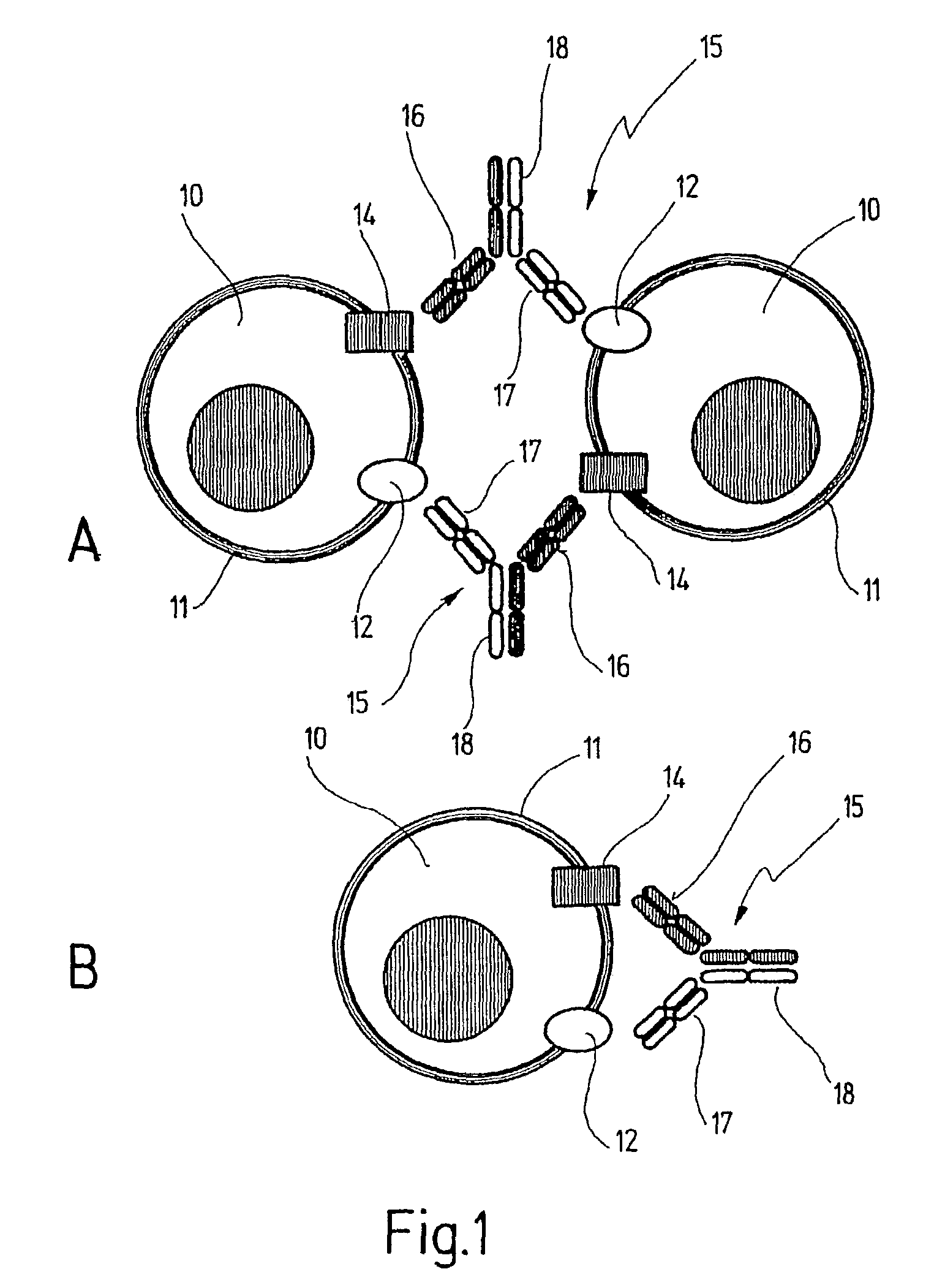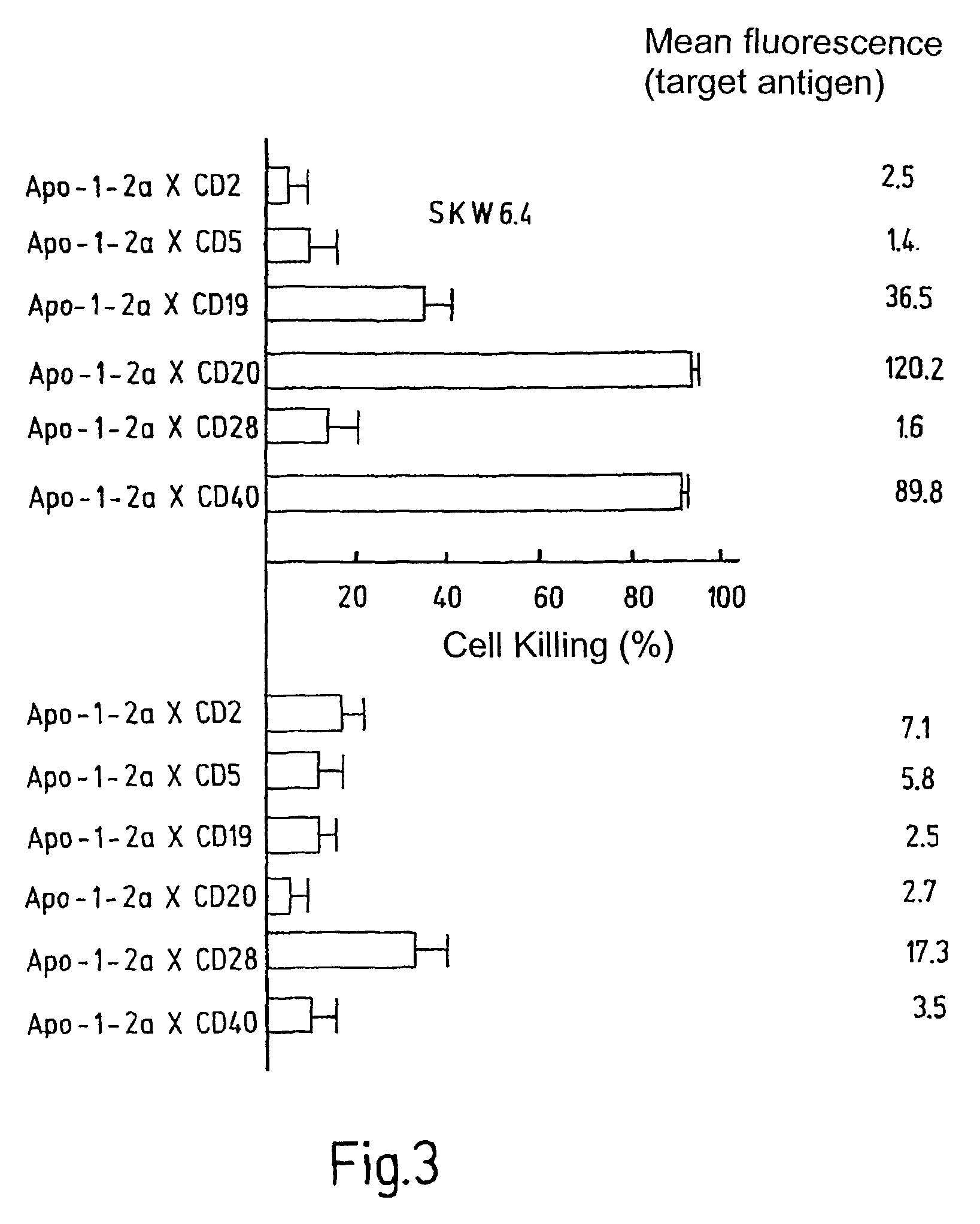Multispecific reagent for selectively stimulating cell surface receptors
a cell surface receptor and multi-specific technology, applied in the field of stimulating cells, can solve the problems of subpopulations, restricted t cell receptor activation mechanism, and not only an attack on tumor cells
- Summary
- Abstract
- Description
- Claims
- Application Information
AI Technical Summary
Benefits of technology
Problems solved by technology
Method used
Image
Examples
example 1
Binding Bispecific Antibodies to Target Cells
[0062]FIG. 1 depicts target cells 10 on each of whose surfaces 11 a cell surface receptor 12 and a target antigen 14 are expressed.
[0063]A bispecific antibody 15, whose Fab fragment 16 possesses a binding site for the target antigen 14 and whose Fab fragment 17 possesses a binding site for the cell surface receptor 12 binds to the target cells 10. The Fc fragment is not involved either in the binding or in a crosslinking, for which reason it was possible to use antibody fragments lacking an Fc moiety in the experiments described below. The bispecific antibody 15, which recognizes the two antigens 12 and 14, binds to both antigens on the same cell.
[0064]The cell surface receptors 12 on the target cells 10 are only stimulated when the Fab fragment 16 is simultaneously able to bind to a target antigen 14.
[0065]On the other hand, the possibility of the bispecific antibody 15 linking two target cells 10 with each other in a bicellular manner, ...
example 2
Cell Lines Employed
[0069]The cell lines employed are SKW6.4 cells and Jurkat cells. SKW6.4 cells (ATCC: TIB 215) are derived from B-lymphocytes and express CD95 (APO-1) and are apoptosis-sensitive.
[0070]Jurkat cells (ATCC: TIB 152) are derived from T-lymphocytes and also express CD95 and are apoptosis-sensitive.
[0071]Both the cell lines are incubated in RPMI 1640 medium which is supplemented with 10 mM glutamate, 100 U / ml of penicillin, 100 μg / ml of streptomycin and 10% heat-inactivated fetal bovine serum (Sigma, Deisenhofen, Germany).
[0072]The APO-1 receptor (CD 95), which is expressed on both cell lines, was selected as the cell surface receptor while the CD markers CD2, CD5, CD19, CD20, CD28 and CD40 were selected as target antigens.
[0073]CD95 antibodies can be purchased from Santa Cruz Biotechnology, Santa Cruz, Calif. Monoclonal antibodies which are directed against the 6 target antigens employed can be obtained, for example, from Biotrend Chemikalien GmbH, Eupener Straβe 157, ...
example 3
Preparing Bispecific Antibody Fragments
[0076]Bispecific antibody fragments were prepared by selectively reducing and reoxidizing disulfide bridges in the joint region; see, for example, Jung et al. loc. cit. The reaction conditions which were used were selected such that the formation of homodimers was prevented and it was possible to hybridize the modified original Fab fragments almost completely.
[0077]For the subsequent experiments, the IgG2a variant of the APO-1 antibody was hybridized with antibodies which are directed against the antigens CD19, CD20 and CD40 on SKW6.4 cells and against the antigens CD2, CDS and CD28 on Jurkat cells.
[0078]In the figures, the bispecific antibody fragments which were prepared in this way are identified by their two specificities, which are separated from each other by an X.
PUM
 Login to View More
Login to View More Abstract
Description
Claims
Application Information
 Login to View More
Login to View More - R&D
- Intellectual Property
- Life Sciences
- Materials
- Tech Scout
- Unparalleled Data Quality
- Higher Quality Content
- 60% Fewer Hallucinations
Browse by: Latest US Patents, China's latest patents, Technical Efficacy Thesaurus, Application Domain, Technology Topic, Popular Technical Reports.
© 2025 PatSnap. All rights reserved.Legal|Privacy policy|Modern Slavery Act Transparency Statement|Sitemap|About US| Contact US: help@patsnap.com



